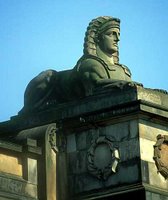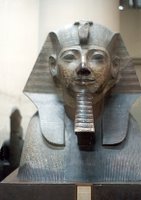Sphinx History
The first appearance of a 'sphinx' in history occurred in Ancient Egyptian culture and they were depicted with the body of a lion and the head of either a human, ram or falcon. The Egyptians believed that the Sphinx warded off all evils from the cemetery around the pyramids.
The word 'sphinx' comes from the Greek 'sphingo' (to strangle) or 'sphingein" (to bind tightly). The Egyptian Arabic name Abul-Hol, which translates as Father of Terror, came to be widely used. It is not known for sure what the Sphinx was called by the Ancient Egyptians themselves, although there is evidence that it was referred to circa 1500 B.C.E. as Hor-em-akht (or Horus in the Horizon), Bw-How (place of Horus) and also as Ra-horakhty (Ra of Two Horizons). (If you know me, you may also know that I wear an Eye of Ra or Eye of Horus ring on the middle finger of my left hand.)
 The largest and most popular sphinx is, of course, the Sphinx in Giza, Egypt. Made from porous limestone, the Sphinx in Giza is over 70 meters long and over 20 meters high. Popular opinion claims that the Sphinx in Giza was built by the Pharoah Khafre of Egypt about 5000 years ago (around 2723-2563 BCE), but some experts claim that the sphinx may be MUCH older and think the Sphinx may have been constructed prior to Ancient Egyptian civilization.
The largest and most popular sphinx is, of course, the Sphinx in Giza, Egypt. Made from porous limestone, the Sphinx in Giza is over 70 meters long and over 20 meters high. Popular opinion claims that the Sphinx in Giza was built by the Pharoah Khafre of Egypt about 5000 years ago (around 2723-2563 BCE), but some experts claim that the sphinx may be MUCH older and think the Sphinx may have been constructed prior to Ancient Egyptian civilization.
Sphinxes have been imported from Egypt and/or constructed all over the world. They can be seen in places such as St. Petersburg, Russia...

Paris, France...

and even Edinburgh, Scotland.

There was also a sphinx constructed in the likeness of Queen Hatshepsut (the first female pharoah of both Upper and Lower Egypt, and step-mother/aunt
and regent to the famous boy-king Tutankamun) c. 1490-1470 BCE.
The Legend
The story goes something like this...
The Sphinx lay on top of a rock just outside of Thebes, Egypt, and had a riddle she would ask of all those who passed. If they answered correctly the Sphinx would allow them to pass safely. Those who could not solve the riddle were strangled by her. The Sphinx thought that the riddle was difficult and that it would remain unsolvable. The riddle went as such: "What animal is that which in the morning goes on four feet, at noon on two, and in the evening on three?". Oedipus had no fear of her and bravely put himself to the challenge. Sure enough, Oedipus answered the riddle correctly by responding "Man, who in childhood creeps on hands and knees, in manhood walks erect, and in old age with the aid of a staff." When the Sphinx heard this, she was such a state of shock and disbelief at having had someone solve her riddle that she flung herself off of her rock and killed herself.
Nietzsche and The Sphinx
Not only have I always been fascinated with Ancient Egyptian history, architecture and mythology, but, as you know, I have also been profoundly influenced by German philosopher, Friedrich Wilhelm Nietzsche (1844-1900). I was quite pleasantly surprised to learn that Nietzsche wrote about the Sphinx.
Says Nietzsche in 'Beyond Good and Evil',
"The Will to Truth, which is to tempt us to many a hazardous enterprise, the famous Truthfulness of which all philosophers have hitherto spoken with respect, what questions has this Will to Truth not laid before us! What strange, perplexing, questionable questions! It is already a long story; yet it seems as if it were hardly commenced. Is it any wonder if we at last grow distrustful, lose patience, and turn impatiently away? That this Sphinx teaches us at last to ask questions ourselves? Who is it really that puts questions to us here? What really is this "Will to Truth" in us? In fact we made a long halt at the question as to the origin of this Will--until at last we came to an absolute standstill before a yet more fundamental question. We inquired about the value of this Will. Granted that we want the truth: Why not rather untruth? And uncertainty? Even ignorance? The problem of the value of truth presented itself before us--or was it we who presented ourselves before the problem? Which of us is the Oedipus here? Which the Sphinx? It would seem to be a rendezvous of questions and notes of interrogation. And could it be believed that it at last seems to us as if the problem had never been propounded before, as if we were the first to discern it, get a sight of it, and risk raising it? For there is risk in raising it, perhaps there is no greater risk."
- Sweden makes 'Sphinx' handguns (Sphinx Systems, that is)
- Author Robin Cook wrote a book entitled "Sphinx"
- 'Sphynx' is the name for a breed of hairless cat
- Sphinx is the name for a genus of moth
- 'Sphinx' is the name of an American test satellite
- There is even a sculpture of the model Kate Moss by the artist Marc Quinn (hehehe)


2 comments:
I've heard about the Sphinx legend before. Very fascinating.
Anyway, I have a blog now. Feel free to drop by.
Oops, I forgot to leave my URL. http://non-compos-mentis.blogspot.com
Post a Comment